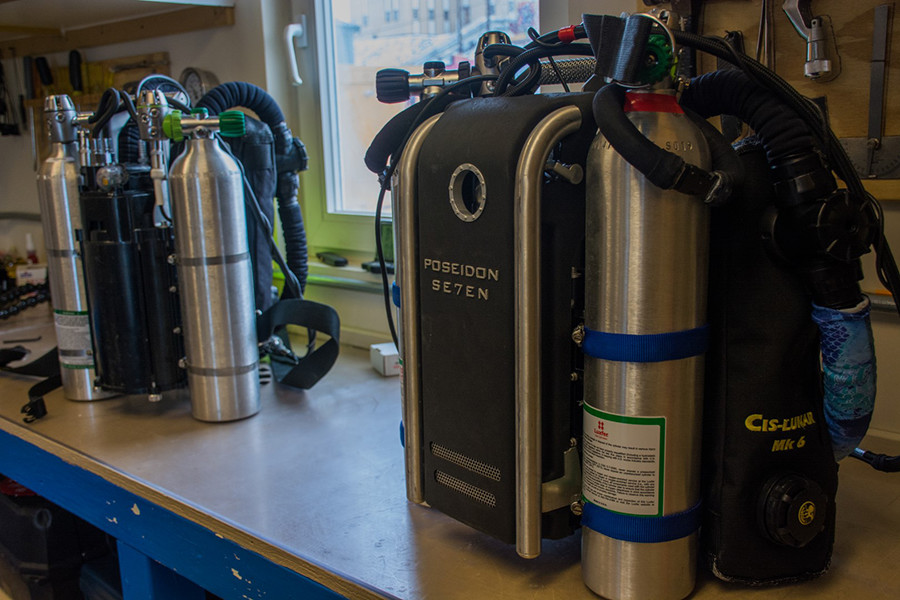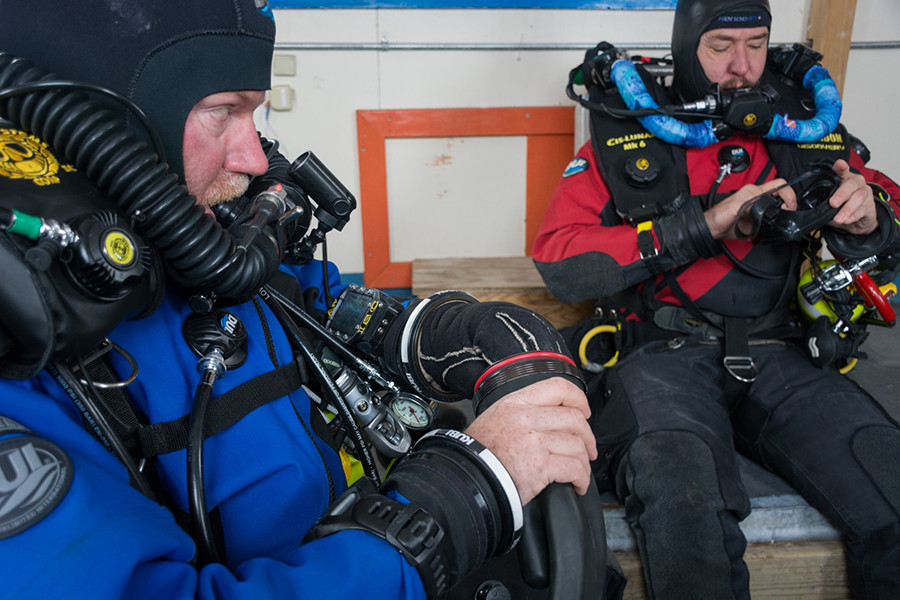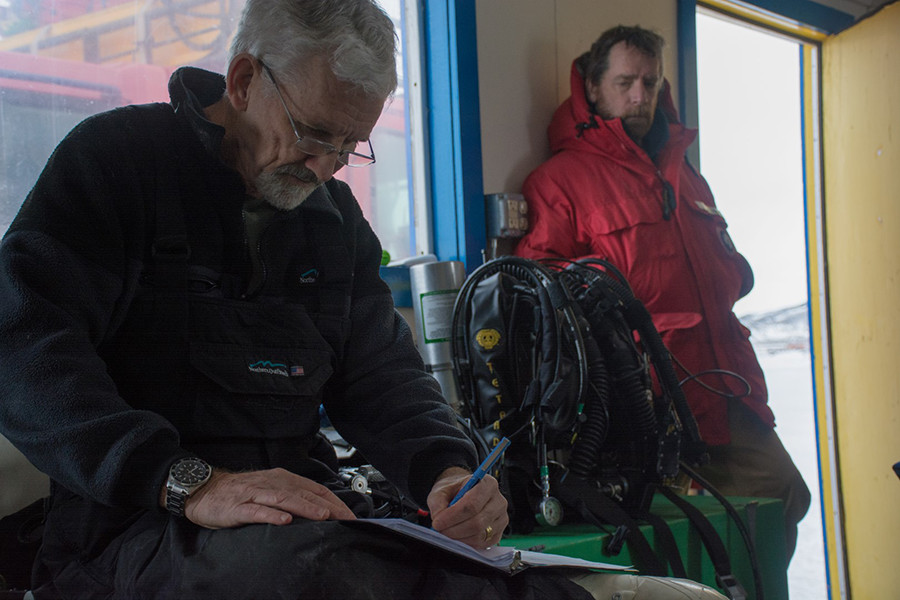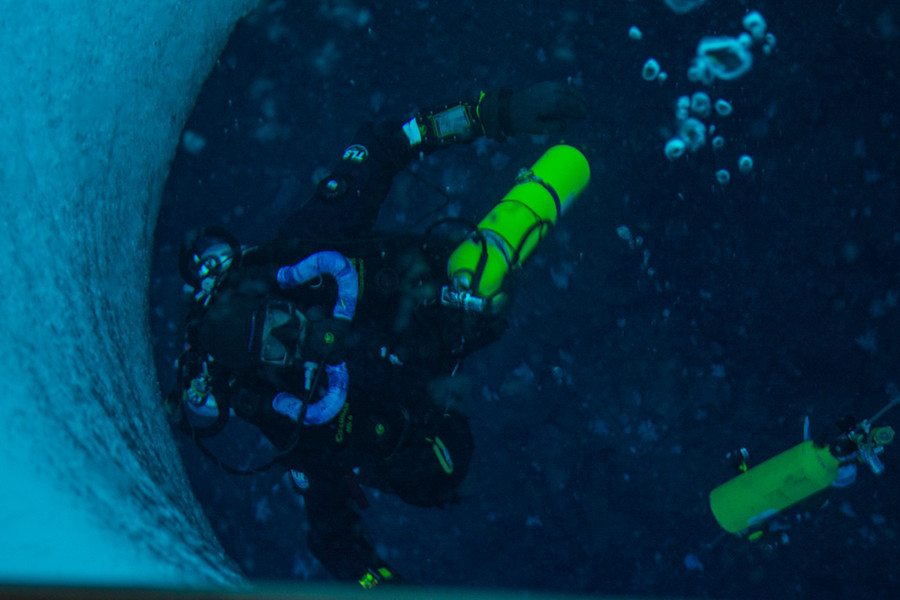A Re-Breath of Fresh AirDivers test new underwater diving systemsPosted November 1, 2016
Over the past few years, there have been major advances in scuba equipment. However, Antarctica is a harsh continent, as the saying goes, and new technology and techniques have to be carefully tested before they are allowed into the field. 
Photo Credit: Jeffrey Bozanic
Inside the station’s dive locker, two rebreather systems sit on the desk, prepped and ready to be taken out for a day of diving.
This season, the McMurdo Station scientific dive team is evaluating the safety of new “rebreather” diving systems that have been growing in popularity. Traditional “open circuit” scuba systems, which divers in McMurdo have been using for years, compress air into a cylinder from which the diver inhales throughout a dive. All the air the diver breathes out is released into the surrounding water. Rebreathers, on the other hand, capture that exhaled air. The system cleans it by running it through a carbon-dioxide scrubber and replenishes the depleted oxygen from an oxygen tank on the back of the diver. It then recirculates the now-restocked air back to the diver. 
Photo Credit: Mike Lucibella
Inside a diving hut, Steve Rupp dons a rebreather before a dive under the sea ice.
“The technology is maturing; they’re becoming much more mainstream,” said Rob Robbins, the dive supervisor for the National Science Foundation-managed U.S. Antarctic Program. Though more complicated, rebreather systems offer a number of advantages over open-circuit scuba systems. The main benefit for scientific diving in Antarctica is that they minimize disruption to wildlife and the environment. “[Rebreathers] don’t emit bubbles so the animals’ behaviors have less of a tendency to change,” said Jeffrey Bozanic, an independent expert on the project who is considered one of the leading experts on rebreather technology. “A lot of animals that you would never see while on open circuit you’ll see on rebreathers, or you’ll see animals that you see commonly go about their day-to-day business without being interested in what is going on with the divers, because of the bubbles.” In addition, rebreathers would also minimize disruption to the lakes in the McMurdo Dry Valleys formed from glacial runoff. Beneath their frozen surface, the water is stratified into multiple distinct bands with different temperatures, salinity and water chemistry. “It’s like a layer cake of different water chemistries as you go up and down through the lake,” Bozanic said. 
Photo Credit: Mike Lucibella
Before diving in, divers Christian McDonald (left) and Steve Rupp prime their rebreathers to get the mix of oxygen correct.
Using rebreathers to minimize the release of bubbles would keep the layers from mixing and disrupt the microorganisms living in the lake less than with open circuit scuba systems. In warmer waters, rebreathers also allow divers to dive deeper and stay under for longer, but the frigid Antarctic temperatures keep most divers from staying under for much more than about 45 minutes at a time. The dive team is trying out six different rebreather systems in the frigid Antarctic environment. If successful, future science projects would be allowed to use the new dive technology under the sea ice, which could open up new science opportunities. “This project is really just to see how well they work and if we feel comfortable with possibly recommending them to our diving control board who would make that decision and decide if they’re worthwhile,” said John Heine of Jacksonville University and principal investigator of the evaluation project. 
Photo Credit: Mike Lucibella
Steve Rupp swims along the seafloor while using a rebreather. The hose leading to and from his mouth carries clean replenished air in on one side and depleted exhaled air out the other. The yellow tank is a backup, emergency air supply.
The Scientific Diving Control Board is the administrative body charged by the National Science Foundation with overseeing the safety of the U.S. Antarctic Program’s research diving practices and approving the use of any new equipment. Most diving equipment is factory tested to the industry standard of 4 degrees Celsius (39.2 degrees Fahrenheit), but the waters around Antarctica can get as low as minus 1.8 degrees Celsius (28.8 degrees Fahrenheit). Because these rebreather systems haven’t been tested in such extreme temperatures, the dive team and the diving control board, which oversees the safety procedures of the program, wanted to test the systems to ensure they’re safe. So far the results of the tests look favorable. “Generally they’ve been going pretty well,” Heine said. “We’ve had a few little alarm issues and things like that that are easily dealt with. Kind of to be expected. Nothing really serious.” To get a complete picture of how the six different systems respond to the freezing conditions in Antarctica, the dive team has been putting them through their paces: They’ve been diving after leaving them out in the cold to simulate a long drive to a dive hole. They’ve put thermal stress on them by moving them repeatedly from warm huts to the cold outside to see how the systems respond to rapid temperature changes. And after filling their breathing tubes with moist air, left them out in sub-zero air to see what happens when they have moisture on the inside of their respirators. 
Photo Credit: Mike Lucibella
John Heine (left) marks down information about the dive in his notebook while Rob Robbins looks on.
“We have not seen a significantly higher failure rate here,” said Bozanic. “With the way we’re transporting them from warm environments to warm shelters and using them right away in the way that we would in other warm environments in other places, we see all those same kinds of errors we would diving in the tropics or in California’s temperate water. We have not yet seen a proportionately higher rate here.” Though the U.S. military has been using rebreathers for diving since World War Two, commercial and scientific divers have only recently started adopting the technology as it has advanced. “Over the last 20 years, there have been orders of magnitudes of improvements in the equipment, in the design characteristics, the safety components that are used and the reliability of the different components used in the rebreathers,” Bozanic said. 
Photo Credit: Mike Lucibella
After a dive, Christian McDonald checks the readings on his diving computer’s eyepiece.
As they’ve grown in popularity within the community, there has been a growing interest to use rebreathers for scientific diving under the sea ice in Antarctica. “We’ve had a few requests from people and just queries about ‘Can I use a rebreather down there?’” Heine said. “We couldn’t really answer that until we know with some certainty that they will operate safely and reliably and get the work done.” Throughout the testing process, the team is meticulously documenting how the systems respond to their testing in order to identify potential issues before anyone takes a rebreather down on a scientific dive. “We’re going to have some nice numbers and some nice data to be able to say ‘This is an issue. That is important’, or ‘This really isn’t,” Heine said. NSF-funded research in this story: John Heine, Jacksonville University, Award No. 1553824. |



For USAP Participants |
For The Public |
For Researchers and EducatorsContact UsU.S. National Science FoundationOffice of Polar Programs Geosciences Directorate 2415 Eisenhower Avenue, Suite W7100 Alexandria, VA 22314 Sign up for the NSF Office of Polar Programs newsletter and events. Feedback Form |


